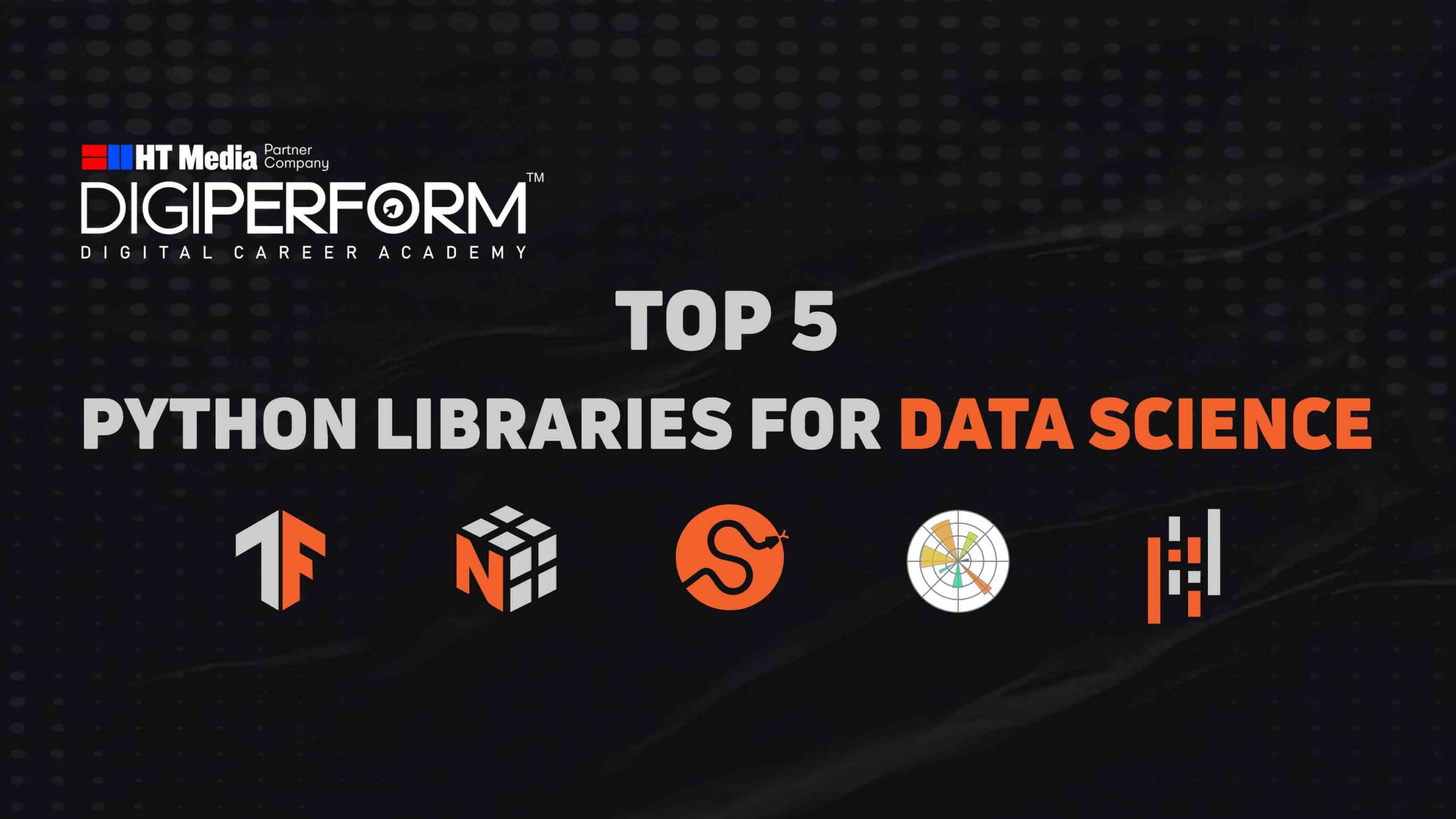Master
Data Science Courses
India’s Only Data Science Training Program created to help you to build a successful career in Data Science from scratch.
Top 5 Python Libraries For Data Science
Most of the data scientists are already leveraging the power of Python. Python is the most widely used programming language today. When it comes to solving data science tasks and challenges, Python never ceases to surprise its audience.
So let us start knowing about all the Top 5 Python Libraries one by one which play an important role in the data science course key task.
1. TENSORFLOW
So TensorFlow is a library for high-performance numerical computations with around 35,000 GitHub commits and a vibrant community of around 1500 contributors and it’s used across various scientific domains. It’s a framework where we can Define and run computations that involve tensors and tensors. We can say are partially defined computational objects again, where they will eventually produce a value that is about TensorFlow.
Let’s talk about the features of TensorFlow. TensorFlow is majorly used in deep learning models and neural networks where we have other libraries like torch and piano also but Tensorflow has hands-down better computational graphical visualizations when compared to them. Also, tensorflow reduces the error largely by 50 to 60 percent in neural machine translations. It’s highly parallel in a way that it can train multiple neural networks and multiple GPUs for highly efficient and scalable models. This parallel computing feature of TensorFlow is also called pipelining. Also, TensorFlow has the advantage of seamless performance as it’s backed by Google. It has quicker updates and frequently releases with the latest features.
Now let’s look at some applications. TensorFlow is extensively used in speech and image recognition, text-based applications, time series analysis and forecasting, and various other applications involving video detection. So favorite thing about TensorFlow is that it’s already popular among the machine learning community and most are open to trying it and some of us are already using it.
2. NUMPY
Now let’s talk about a common yet very powerful Python library called NumPy. NumPy is a fundamental package for numerical computation in Python. It stands for numerical Python as the name suggests. It has around 18,000 commits on GitHub with an active community of 700 contributors. It’s a general-purpose array processing package in a way that provides high-performance multi-dimensional objects called arrays and tools for working with them. Also, NumPy addresses the slowness problem partly by providing these multi-dimensional arrays that we talked about and then functions and operators that operate efficiently on these arrays interesting, right?
Now, let’s talk about the features of numbers. It’s very easy to work with large arrays and mattresses using NumPy. NumPy fully supports an object-oriented approach. For example, coming back to Ndra once again, it’s a class possessing numerous methods and attributes Ndra provides for larger and repeated computations. NumPy offers vectorization. It’s more faster and compact than traditional methods. We always wanted to get rid of loops and vectorization of NumPy helps us with that.
Now, let’s talk about the applications of NumPy. NumPy along with pandas is extensively used in data analysis, which forms the basis of data science. It helps in creating a powerful n-dimensional array. Whenever we talk about numpy we mention the array, we cannot do it without the mention of the powerful n-dimensional array. Also numpy is extensively used in machine learning when we are creating machine learning models as in where it forms the base of other libraries like scipy scikit-learn Etc. When you start creating the machine learning models in data science, you will realize that all the models will have their basis numpy or pandas also when number is used with scipy and matplotlib. It can be used as a replacement for Matlab.
3. SCIPY
Now let’s discuss the next library which is SciPy. So this is another free and open-source Python library extensively used in data science for high-level competitions. So this library as the name suggests stands for scientific Python and it has around 19,000 commits on GitHub with an active community of 600 contributors. It is extensively used for scientific and technical competitions. Also as it extends NumPy, it provides many user-friendly and efficient routines for scientific calculations.
Now, let’s discuss some features of SciPy. It has a collection of algorithms and functions which is built on the NumPy extension of Python. Secondly, it has various high-level commands for data manipulation and visualization. Also, the ND image function of SciPy is very useful in multi-dimensional image processing and it includes built-in functions for solving differential equations, linear algebra, and many more. So that was about the features of scipy.
Now let’s discuss its applications. Scipy is used in multi-dimensional image operations. It has functions to read images from disk into numpy arrays, write arrays to disk, discuss images, resize images etc. Solve differential equations, Fourier transforms, then optimization algorithms, linear algebra, etc.
4. PANDAS
Data analysis is an integral part of data science. Data scientists spend most of the day in data munching and then cleaning the data also. Hence, mention of pandas is a must in the data science life cycle. Yes, pandas is the most popular and widely used Python library for data science along with numpy and matplotlib. The name itself stands for Python Data Analysis with around 17,000 commits on GitHub and an active community of 1200 contributors. It is heavily used for data analysis and cleaning as it provides fast, flexible data structures like data frames, series, which are designed to work with structured data very easily and intuitively.
Now let’s talk about some features of Pandas. So Pandas offers this eloquent syntax and rich functionalities like there are various methods in pandas like dropNA, fillNA which gives you the freedom to deal with missing data. Also pandas provides a powerful apply function which lets you create your own function and run it across a series of data. Now forget about writing those for loops while using pandas. Also this library is a high level abstraction over low-level NumPy which is written in pure C. Then it also contains these high-level data structures and manipulation tools which makes it very easy to work with Pandas like their data structures and series.
Now let’s discuss the applications of Pandas. So Pandas is extensively used in general data wrangling and data cleaning. Then Pandas also finds its usage in ETL jobs for data transformation and data storage as It has excellent support for loading CSV files into its data frame format. Then pandas are used in a variety of academic and commercial domains including statistics, finance, neuroscience, economics, web analytics, etc. Then pandas are also very useful in time series-specific functionality like date range generation, moving window linear regression, date shifting, etc.
5. MATPLOTLIB
Now let’s talk about the next library and the last one. So matplotlib for me is the most fun library out of all of them. Why? Because it has such powerful yet beautiful visualizations. The plot in matplotlib suggests that it’s a plotting library for Python. It has around 26,000 commits on GitHub and a very vibrant community of 700 contributors. And because of such graphs and plots that it produces, it’s majorly used for data visualization. And also because it provides an object-oriented API that can be used to embed those plots into our applications.
Let’s talk about the features of my plot lip. The pie plot module of my plot lip provides a matlab-like interface. So matplotlib is designed to be as usable as Matlab with the advantage of being free and open source. Also, it supports dozens of backends and output types, which means you can use it regardless of which operating system you’re using or which output format you wish. Pandas itself can be used as wrappers around Matplotlib’s API, to drive Matplotlib via cleaner and more modern APIs. Also when you start using this library, you will realize that it has very little memory consumption and a very good runtime behavior.
Now let’s talk about the applications of Matplotlib. It’s important to discover the unknown relationship between the variables in your data set. So this library helps to visualize the correlation analysis of variables. Also in machine learning, we can visualize 95% confidence interval of the model just to communicate how well our model fits the data. Then Matplotlib finds its application and outliers detection using scatter plots etc. and visualizes the distribution of data to gain instant insights.
Conclusion:
I hope you like all the information we have given you in this article about Python libraries for data science.
Before I end, I would like to say that if you Want to make a career in this field of achievement you can do an Online Data science course (Master Certification Program in Analytics, Machine Learning, and AI) from Digiperform. India’s Only Most Trusted Brand in Digital Education
In this Data science online course You will solve 75+ projects and assignments across the project duration working on Stats, Advanced Excel, SQL, Python Libraries, Tableau, Advanced Machine Learning, and Deep Learning algorithms to solve day-to-day industry data problems in healthcare, manufacturing, sales, media, marketing, education sectors making you job ready for 30+ roles.
And to get your dream job Digiperform’s dedicated placement cell will help you with 100%* placement assistance.
FAQs:
What are Python libraries for data science?
Python libraries for data science are sets of pre-written code that help people analyze and manipulate data easily. They make it simpler for humans, like you, to work with data in tasks such as finding patterns, making predictions, and creating visualizations.
Which Python library is best for handling tables of data?
Pandas is a popular Python library for handling tables of data. It provides easy-to-use data structures and tools for working with structured data, like spreadsheets or SQL tables. With Pandas, you can filter, sort, and analyze your data effortlessly.
What's the purpose of Matplotlib in data science?
Matplotlib is a Python library that makes it easy to create various types of plots and charts. It's like drawing graphs but in code. With Matplotlib, you can visualize your data, making it simpler to understand and share insights with others.
How does Scikit-learn help in data science projects?
Scikit-learn is a powerful Python library for machine learning. It provides tools for building and training machine learning models. If you want to predict something based on your data or find patterns, Scikit-learn can be your go-to helper.
What does NumPy do concerning data science?
NumPy is a Python library that adds support for large, multi-dimensional arrays and matrices, along with mathematical functions to manipulate them. It's like a super calculator for handling numerical operations efficiently. Data scientists often use NumPy for tasks like linear algebra and statistical analysis.











